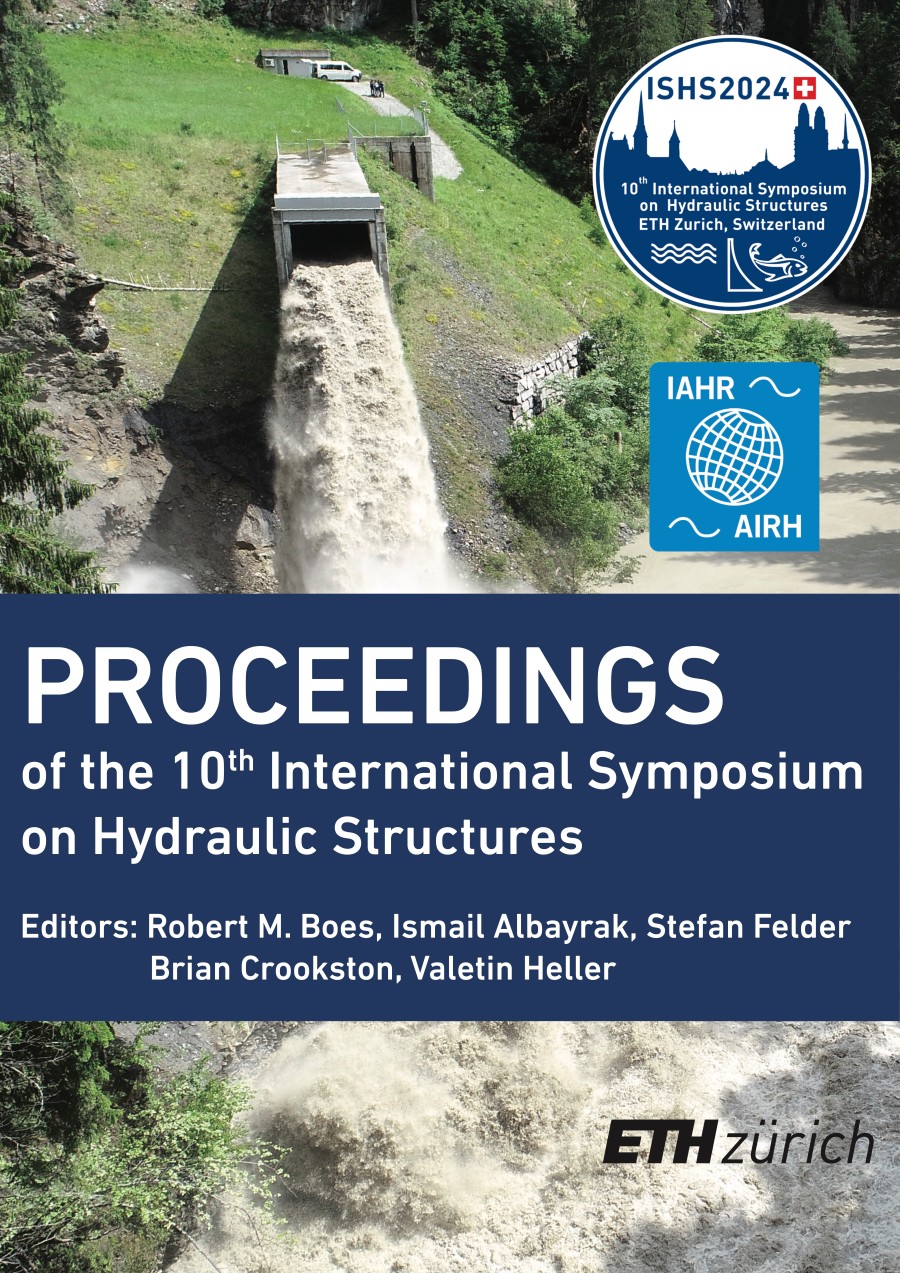IAHR Document Library

Proceedings of the 10th International Symposium on Hydraulic Structures (Zurich, 2024)
- ISSN Online: 0374-0056
- ISSN Print:
- ISBN:
- Publisher: IAHR
- Editor(s): Robert M. Boes; Ismail Albayrak; Stefan Felder; Brian Crookston; Valentin Heller
- Related: Committee on Hydraulic Structures
The Proceedings of the 10th IAHR International Symposium on Hydraulic Structures (ISHS 2024), held at ETH Zurich, Switzerland, from June 17 to 19, 2024, followed by the 9th International Junior Researcher and Engineer Workshop (9th IJREWHS) on Hydraulic Structures on June 20, contain technical papers on diverse and novel aspects of hydraulic structures.
Hydraulic structures are key components of hydraulic engineering and water resources management. These disciplines address important topics and questions in an era of rapid technological development, urgency in reducing the carbon footprint and maintaining a secure water infrastructure for humanity, not least to protect against natural hazards, supply society with water for potable use, industry and irrigation in good quality and sufficient quantity, as well as to produce clean and affordable energy. Hydraulic engineering and structures are hence pivotal to fulfill several of the United Nations’ sustainable development goals. Research and development, optimization, implementation, operation, maintenance and refurbishment of hydraulic structures are challenging tasks of hydraulic engineers to contribute to safe, reliable and sustainable hydraulic infrastructure in a changing world. Recent major flood events in many parts of the world are dramatic illustrations of the dangers that can emanate from water. Flooding is the most significant natural hazard in many countries and there will never be 100% safety against it. Nevertheless, effective flood protection measures can reduce flood risk by limiting damage and, above all, saving lives. Modern and well-designed flood control infrastructure has demonstrated the effectiveness of the protective measures taken and the benefits of effective emergency action plans, warning and alert systems, and the well-coordinated emergency and crisis management personnel. As meteorological and hydrological processes can take on immense intensities and dimensions out of humans’ control, a priority approach is to avoid the danger zones with suitable spatial planning measures.
However, water is not only a source of danger, but also a valuable resource. In many countries, the energy transition and the net-zero target for greenhouse gas emissions can only be achieved with a significant contribution from hydropower to electricity generation and, in particular, energy storage. The challenges are significant as renewable energies, including hydropower, are to be expanded to satisfy climate-friendly energy needs while simultaneously meeting aquatic ecology goals such as improving the continuity of watercourses for organisms, fish, sediments and organic matter like large wood. Hydraulic structures for both protection against natural hazards and for utilization purposes are built in natural water systems and therefore always interact with biodiversity and habitat requirements. This is challenging for engineers working in hydraulic engineering and designing hydraulic structures, as there are conflicting interests to make watercourses more natural and thus increase biodiversity despite the increasing pressure to use them for the benefit of humankind.
Editors
Robert Boes, Ismail Albayrak, Stefan Felder, Brian Crookston, Valentin Heller
Publisher
ETH Zurich
| ID | Title | Authors | Year |
|---|---|---|---|
| 30182 | Testing a smoothed-particle hydrodynamics (SPH) code to solve the hydrodynamics of a bottom intake Coanda screen |
Jose M. Carrillo; Juan T. Garcia; Katherine Guachamin-Paladines; Alicia Ros Bernal; Luis G. Castillo
|
2024 |
| 30183 | Free Surface Vortices at Intakes: Influence of Different Intake Geometries on Critical Submergence and Air Entrainment |
Lukas M. Schneider; Davood Farshi; Giovanni De Cesare; Pasha Piroozmand
|
2024 |
| 30184 | Flow around an isolated boulder-like obstacle: effects of modeling approach and Reynolds number |
Yannick Marschall; George Constantinescu; Robert Boes; David F. Vetsch
|
2024 |
| 30185 | Discharge Characteristics of Piano Key Side Weirs |
Sabir Hussain; Ali Shariq; Zulfequar Ahmad
|
2024 |
| 30186 | Composite Modeling to Detect Scale Effects in Embankment Dam Breaching due to Overtopping |
Matthew Christopher Halso; C. L. Knusel; David F. Vetsch; Frederic M. Evers; Robert Boes
|
2024 |
| 30187 | Durability of Concrete Structures – Inspection of Lock Chambers |
Stefan Kubens; Juan Mauricio Lozano-Valcarcel; Thomas Krankel; Amir Rahimi; Christoph Muller; Christoph Gehlen
|
2024 |
| 30188 | Scour Evolution at Rock Sills under Unsteady Flow Condition |
Michele Palermo; Sahameddin Mahmoudi Kurdistani; Stefano Pagliara
|
2024 |
| 30189 | Flood protection of Zurich: Physical modelling of the intake structure of a flood diversion tunnel |
Andris Wyss; Florian Hinkelammert-Zens; Robert Boes; Michael Muller; Adrian Stucki; Volker Weitbrecht
|
2024 |
| 30190 | Rapidly Varied Flow in a Complex Hydraulic Control Structure |
Robert Feurich; Stefan Thonhauser
|
2024 |
| 30191 | Impact of bed level changes on overflow at lateral diversion structures using different numerical modelling approaches |
Seline Frei; Robert Boes; David F. Vetsch
|
2024 |